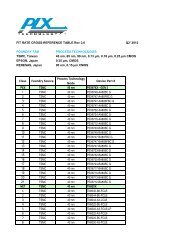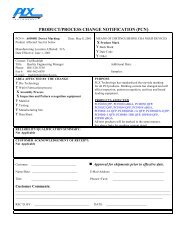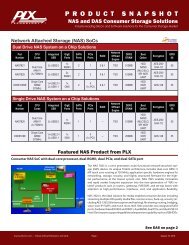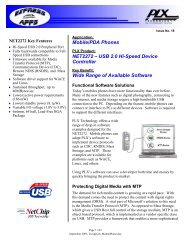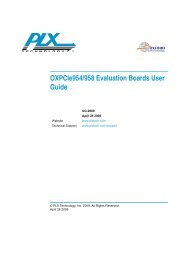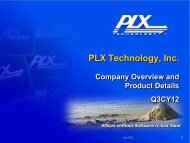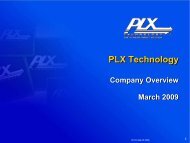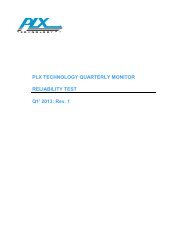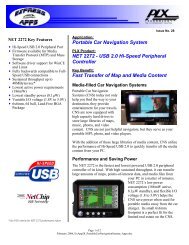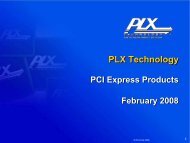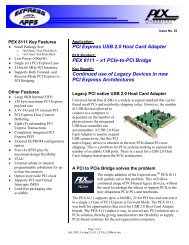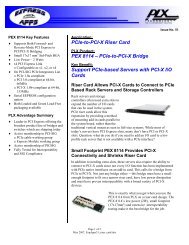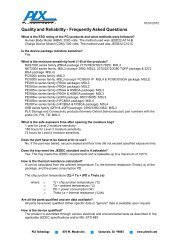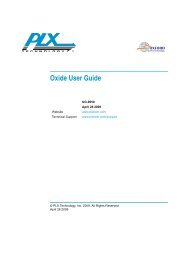the 2009 Annual Report (pdf) - PLX Technology
the 2009 Annual Report (pdf) - PLX Technology
the 2009 Annual Report (pdf) - PLX Technology
You also want an ePaper? Increase the reach of your titles
YUMPU automatically turns print PDFs into web optimized ePapers that Google loves.
Comprehensive Income (Loss)<br />
The components of accumulated o<strong>the</strong>r comprehensive income (loss), reflected in <strong>the</strong> Consolidated Statements of<br />
Stockholders' Equity and Comprehensive Income (Loss), consisted of <strong>the</strong> following (in thousands):<br />
Years Ended December 31,<br />
<strong>2009</strong> 2008 2007<br />
Unrealized gain on invest ment s, net ……………………………… $ 28 $ 291 $ 62<br />
Cumulat ive t ranslat ion adjust ment s……………………………… (115) (187) (144)<br />
Accumulat ed ot her comprehensive income (loss)……………… $ (87) $ 104 $ (82)<br />
Recent Accounting Pronouncements<br />
In December 2007, <strong>the</strong> Financial Accounting Standards Board (“FASB”) revised <strong>the</strong> accounting guidance related<br />
to business combinations. This guidance establishes principles and requirements intending to improve <strong>the</strong> relevance,<br />
representational faithfulness and comparability of information that a reporting entity provides in its financial reports<br />
about a business combination and its effects. This guidance became effective for fiscal years beginning after<br />
December 15, 2008. The adoption this guidance on January 1, <strong>2009</strong> changed <strong>the</strong> Company’s accounting treatment<br />
for business combinations. Among o<strong>the</strong>r things, acquisition related costs are required to be expensed as incurred. On<br />
January 2, <strong>2009</strong> <strong>the</strong> Company completed <strong>the</strong> acquisition of Oxford and as a result, it expensed acquisition related<br />
costs of $0.8 million and $0.4 million in <strong>the</strong> fourth quarter of 2008 and in <strong>2009</strong>, respectively.<br />
In April 2008, <strong>the</strong> FASB issued new accounting guidance related to <strong>the</strong> determination of <strong>the</strong> useful life of<br />
intangible assets. This guidance amends <strong>the</strong> factors an entity should consider in developing renewal or extension<br />
assumptions used in determining <strong>the</strong> useful life of recognized intangible assets and adds certain disclosures for an<br />
entity’s accounting policy of <strong>the</strong> treatment of <strong>the</strong> costs, period of extension, and total costs incurred. This guidance<br />
must be applied prospectively to intangible assets acquired after January 1, <strong>2009</strong>. The adoption of this guidance did<br />
not have a material impact on <strong>the</strong> Company’s financial position or results of operations.<br />
In April <strong>2009</strong>, <strong>the</strong> FASB issued three related sets of accounting guidance intended to enhance disclosures<br />
regarding fair value measurements and impairments of securities. This guidance sets forth rules related to determining<br />
<strong>the</strong> fair value of financial assets and financial liabilities when <strong>the</strong> activity levels have significantly decreased in<br />
relation to <strong>the</strong> normal market, guidance related to <strong>the</strong> determination of o<strong>the</strong>r-than-temporary impairments to include<br />
intent and ability of <strong>the</strong> holder as an indicator in <strong>the</strong> determination of whe<strong>the</strong>r an o<strong>the</strong>r-than-temporary exists and<br />
interim disclosure requirements for <strong>the</strong> fair value of financial instruments. These sets of accounting guidance became<br />
effective June 15, <strong>2009</strong>. The adoption of this guidance did not have a material impact on <strong>the</strong> Company’s financial<br />
position or results of operations.<br />
In June <strong>2009</strong>, <strong>the</strong> FASB issued <strong>the</strong> FASB Accounting Standards Codification (ASC). The ASC has become <strong>the</strong><br />
authoritative source of generally accepted accounting principles in <strong>the</strong> United States. Rules and interpretive releases<br />
of <strong>the</strong> Securities and Exchange Commission (SEC) under federal securities laws are also sources of authoritative<br />
GAAP for SEC registrants. ASC became effective for financial statements issued for interim and annual periods<br />
ending after September 15, <strong>2009</strong>. The adoption of <strong>the</strong> ASC did not have a material impact on <strong>the</strong> Company’s<br />
financial position or results of operations.<br />
In January 2010, <strong>the</strong> FASB amended <strong>the</strong> guidance related to fair value disclosures. This amended guidance require<br />
disclosures about inputs and valuation techniques used to measure fair value as well as disclosures about significant<br />
transfers, beginning in <strong>the</strong> first quarter of 2010. Additionally, this guidance requires presentation of disaggregated<br />
activity within <strong>the</strong> reconciliation for fair value measurements using significant unobservable inputs (Level 3),<br />
beginning in <strong>the</strong> first quarter of 2011. The Company does not expect <strong>the</strong> adoption of this guidance to have a material<br />
impact on its financial position or results of operations.<br />
48




